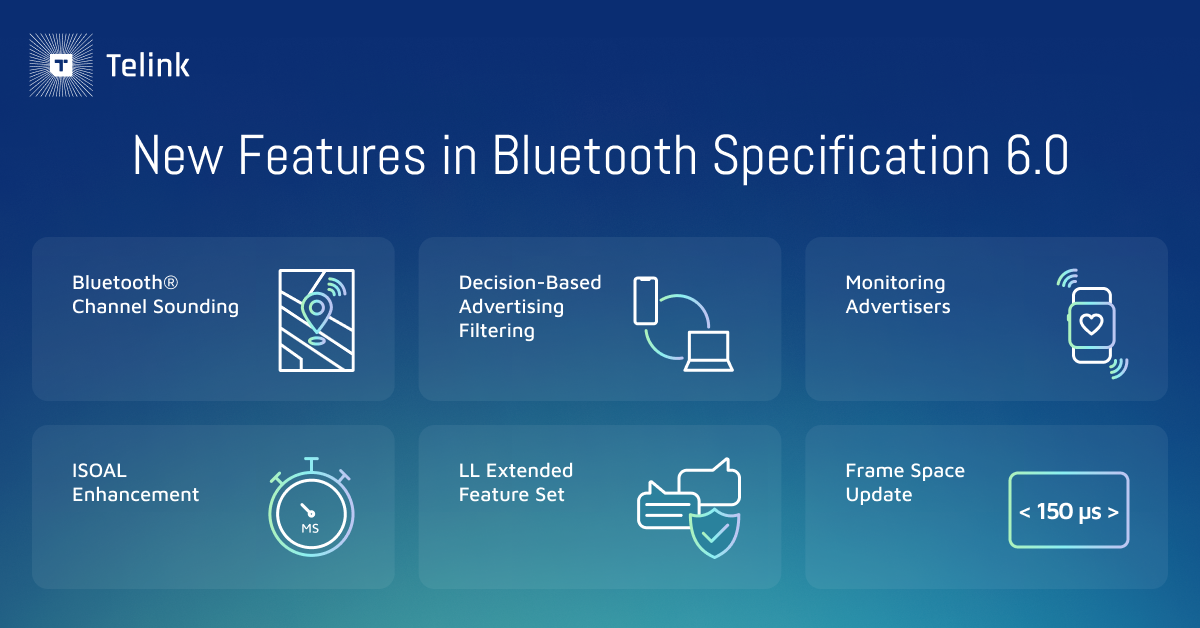


旋转设备


Telink Staff
November 4, 2024

See how the latest Bluetooth upgrade is prepping developers and consumers for the future of connectivity.
Bluetooth® Core Specification 6.0 is here, packed with new capabilities that advance the role of Bluetooth technology in our everyday devices. Following Bluetooth Core Specification 5.4, which introduced groundbreaking features like Periodic Advertising with Responses (PAwR) and Encrypted Advertising Data, version 6.0 expands on these features while offering new ones to meet the rising need for secure, standards-based distance measurement, reliable connectionless data transfer, and improved user experiences. Let’s take a closer look at what this upgrade means for developers and consumers alike.

Version 6.0 offers several standout features that deliver practical enhancements for both developers and end users. Here’s a closer look at each one:
What It Offers: Bluetooth® Channel Sounding adds a new layer of security by ensuring that only authorized users within a specific range can access certain features or areas, such as unlocking doors or accessing secure zones. This feature also introduces true distance awareness, enabling precise location tracking for billions of Bluetooth devices worldwide. For example, in a smart office setup, Bluetooth Channel Sounding could restrict access to meeting rooms by only unlocking doors for employees within a set range, ensuring secure entry and minimizing unauthorized access.
How It Works: This feature leverages Phase-Based Ranging (PBR) and Round-Trip Timing (RTT), two techniques that provide accurate distance measurement. Specifically, PBR calculates distance by measuring the phase difference between signals sent and received by Bluetooth devices, while RTT measures the time it takes for a signal to travel from the originating device to a target device and back again. Both methods can be used individually or together, offering developers flexibility in building location-aware applications.
What It Offers: This feature improves the efficiency of applications that use the Bluetooth® Low Energy (LE) Extended Advertising by enabling a device to assess the content of a packet received on a primary advertising channel, helping determine whether additional scanning on secondary channels is necessary. This streamlined approach reduces scanning time and optimizes power usage. Here, a smart home system could use this feature to filter out irrelevant signals, like those from nearby devices outside the home, focusing only on essential devices, such as security cameras and sensors within its range.
How It Works: The feature introduces a new type of extended advertising PDU called ADV_DECISION_IND (decision PDUs) to be used instead of ADV_EXT_IND (extended advertising PDUs). Decision PDUs carry application-specific data, allowing the scanner to evaluate if further probing on secondary channels is needed.
What It Offers: Before, Bluetooth LE controllers filtered duplicate advertising packets, ensuring that hosts received only one packet per device; however, potential devices in range could not be detected without scanning again. The latest Bluetooth specification introduces monitoring advertisers to enable host devices to detect when other devices of interest move in or out of range. An example use case would be in asset tracking within a warehouse, where monitoring advertisers would notify the system whenever tagged equipment or inventory moves out of range, helping ensure items don’t go missing or leave designated areas.
How It Works: Using Host Controller Interface (HCI) events, monitoring advertisers inform the host when a monitored device exits or re-enters the connection range, reducing redundant reporting while ensuring the host is updated only when the device’s presence changes.
What It Offers: For applications requiring low latency and high audio fidelity, such as Bluetooth audio streaming, ISOAL (Isochronous Adaptation Layer) Enhancement enables larger data frames to be transmitted in smaller link-layer packets, preserving timing data crucial for real-time processing. For example, in a Bluetooth-connected headset, ISOAL enhancement allows seamless audio streaming without lags or buffering, improving the listener’s experience with clearer sound and minimal interruptions, even in high-interference environments.
How It Works: With ISOAL enhancement, Service Data Units (SDUs) are divided into Protocol Data Units (PDUs) and reassembled accurately into the original larger SDU at the receiver end, even if the transmission and production rates are unsynchronized. By preserving timing information, this feature helps receiving devices process data at the correct intervals, minimizing latency for audio and video streams.
What It Offers: Bluetooth Specification 6.0 also facilitates more sophisticated interactions between devices by enabling them to exchange information about the link-layer features they support. This capability is crucial for advanced devices that require seamless interoperability and feature discovery. In a smart medical device ecosystem, for instance, a monitor could instantly recognize and connect with compatible sensors and devices nearby, enhancing patient monitoring by automatically discovering and integrating all necessary features.
How It Works: Using a procedure called Feature Page Exchange, devices share information about their supported features through the LL Extended Feature Set link layer. This exchange, which can be initiated by either the Central or Peripheral device, enables richer interactions and unlocks enhanced capabilities across devices.
What It Offers: Frame spacing, the timing interval between data packets, is now negotiable with the Frame Space Update feature, allowing for customized spacing intervals to optimize data throughput or energy efficiency, depending on the application’s needs. In an IoT sensor network, this feature could allow energy savings by adjusting frame spacing and extending battery life for sensors that only need intermittent data collection, such as environmental monitors.
How It Works: Devices negotiate applicable spacing values for supported physical layers (PHYs) through the Frame Space Update procedure. This negotiation enables applications to customize the spacing to match specific performance or energy-saving requirements, with values no longer limited to 150 µs.
On the developer and end-user sides, Bluetooth Specification 6.0 introduces powerful updates that enhance connectivity, security, and precision, while providing innovators with the tools to build more robust and versatile applications. Here are some key benefits:
With these perks, Bluetooth Specification 6.0 offers developers and end users a significant leap forward in connectivity and precision, empowering a new generation of applications with unmatched performance, seamless integration, and enhanced user experiences.
With a deep reservoir of expertise in Bluetooth® technology, Telink is steadfast in its commitment to providing customers with a wide range of high-performance chips designed to meet diverse application requirements across various scenarios. For example, the TLSR922X and TL721X series of SoC chips are expertly integrated with Bluetooth® Channel Sounding technology, ensuring exceptional support for high-precision positioning.
Furthermore, the TLSR951X, TLSR952X, and other audio SoC chips support Bluetooth® Classic and the latest Low Energy Audio (LE Audio) standards, revolutionizing the audio experience with cutting-edge innovations.
As the Internet of Things (IoT) market continues to grow at an impressive rate, the TLSR825X, TLSR827X, and TLSR921X series of SoC chips emerge as top choices due to their low power consumption and high integration, offering ideal solutions for a multitude of IoT devices.
Plus, with the launch of Bluetooth® Core Specification 6.0, a host of innovative features and upgrades will significantly enhance the applicability of Bluetooth® technology. Telink is set to fully integrate these advancements into the forthcoming Bluetooth Low-Energy SDK, ensuring that customers have access to the latest capabilities.
Customer satisfaction is at the core of Telink's mission, as we relentlessly pursue technological advancement. We empower our clients to seize every opportunity in the Bluetooth 6.0 era and drive their business growth to new heights.
For an in-depth overview of the new Bluetooth specification, please visit the official feature overview here. You can also visit Telink’s wiki to learn more about our development resources or contact us directly today.